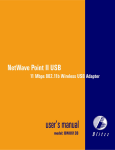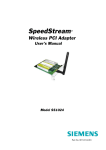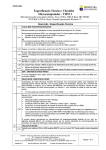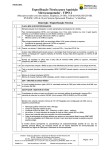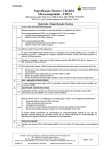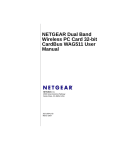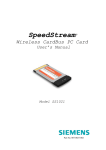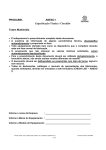Download Blitzz Technology BWU613B User`s manual
Transcript
i Copyright All rights reserved. No part of this document may be reproduced in any format or by any means without written permission from Blitzz Technology Inc. Changes are periodically made to the information in this document. They will be incorporated in subsequent editions. The supplier may make improvements and/or changes in the product described in this document at any time. Blitzz Super G Wireless – 108 Mbps 802.11g Notebook Adapter ii Technical Support Up-to-date information Your newly purchased Blitzz product was created with the latest technology and designs. However, we constantly modify and update the product features to keep you up to date with the latest technologies through firmware or software upgrades. You can visit our web site on www.blitzzusa.com to check if there is new software for your product. Problem solving If you have difficulty resolving problems in installation or have further technical questions, you can go www.blitzzusa.com to look for the latest FAQ or contact us with the following ways: Web site: www.blitzzusa.com Tech support: [email protected] Toll Free: 1-888-4Blitzz (1-888-425-4899) Sales: [email protected] Blitzz Super G Wireless – 108 Mbps 802.11g Notebook Adapter iii Federal Communication Commission Interference Statement This equipment has been tested and found to comply with the limits for a Class B digital device, pursuant to Part 15 of the FCC Rules. These limits are designed to provide reasonable protection against harmful interference in a residential installation. This equipment generates, uses and can radiate radio frequency energy and, if not installed and used in accordance with the instructions, may cause harmful interference to radio communications. However, there is no guarantee that interference will not occur in a particular installation. If this equipment does cause harmful interference to radio or television reception, which can be determined by turning the equipment off and on, the user is encouraged to try to correct the interference by one of the following measures: - Reorient or relocate the receiving antenna. - Increase the separation between the equipment and receiver. - Connect the equipment into an outlet on a circuit different from that to which the receiver is connected. - Consult the dealer or an experienced radio/TV technician for help. FCC Caution: Any changes or modifications not expressly approved by the party responsible for compliance could void the user's authority to operate this equipment. This device complies with Part 15 of the FCC Rules. Operation is subject to the following two conditions: (1) This device may not cause harmful interference, and (2) this device must accept any interference received, including interference that may cause undesired operation. IMPORTANT NOTE: FCC Radiation Exposure Statement: This equipment complies with FCC radiation exposure limits set forth for an uncontrolled environment. This transmitter must not be co-located or operating in conjunction with any other antenna or transmitter. Blitzz Super G Wireless – 108 Mbps 802.11g Notebook Adapter iv About this Manual This User’s Manual describes how to install and operate your Blitzz Super G Wireless LAN Card. Please read this manual before you install the product. This manual includes the following topics: Product description and features. Hardware installation procedure. Software installation procedure. FAQ Blitzz Super G Wireless – 108 Mbps 802.11g Notebook Adapter v Table of Contents COPYRIGHT.................................................................................................................................................. I TECHNICAL SUPPORT ............................................................................................................................... II FEDERAL COMMUNICATION COMMISSION INTERFERENCE STATEMENT....................................... III ABOUT THIS MANUAL...............................................................................................................................IV TABLE OF CONTENTS ...............................................................................................................................V CHAPTER 1 1.1 1.2 1.3 1.4 FEATURES ..................................................................................................................................... 1 WHAT IS WIRELESS LAN? .............................................................................................................. 2 WIRELESS LAN MODES ................................................................................................................. 2 NOTES ON WIRELESS LAN CONFIGURATION ................................................................................... 3 CHAPTER 2 2.1 2.2 2.3 2.4 2.5 2.6 4.6 INSTALLING AND USING THE WIRELESS UTILITY ................................................... 17 INSTALLATION IN WINDOWS .......................................................................................................... 17 USING THE WINDOWS WIRELESS NETWORK UTILITY IN WINDOWS XP ............................................ 19 USING THE BLITZZ WIRELESS LAN UTILITY IN XP.......................................................................... 23 USING THE BLITZZ WIRELESS LAN UTILITY IN WINDOWS 98, 2000 AND ME ................................... 27 CONFIGURING THE BLITZZ 802.11G WIRELESS LAN CARD ............................................................ 29 4.5.1 Link Status: Connection Details.................................................................................... 29 4.5.2 Profiles .......................................................................................................................... 29 5.4.3 Site Monitor: Finding and connecting to wireless networks.......................................... 31 5.4.4 Wireless Security: WEP and WPA (WiFi-Protected Access) ....................................... 32 4.5.5 Information.................................................................................................................... 35 USING SUPER G MODE ................................................................................................................ 36 CHAPTER 5 5.1 DRIVER INSTALLATION FOR WINDOWS ...................................................................... 7 DRIVER INSTALLATION FOR WINDOWS 98 SE .................................................................................. 7 DRIVER INSTALLATION FOR WINDOWS 2000 .................................................................................. 10 DRIVER INSTALLATION FOR WINDOWS ME..................................................................................... 13 DRIVER INSTALLATION FOR WINDOWS XP ..................................................................................... 15 CHAPTER 4 4.1 4.2 4.3 4.4 4.5 HARDWARE INSTALLATION .......................................................................................... 4 PACKAGE CONTENTS ..................................................................................................................... 4 SYSTEM REQUIREMENTS FOR THE ADAPTER ................................................................................... 4 HARDWARE DESCRIPTION ............................................................................................................... 4 INSERTING THE WIRELESS LAN CARD ............................................................................................ 4 LED INDICATORS ........................................................................................................................... 5 EJECTING THE WIRELESS LAN CARD .............................................................................................. 5 CHAPTER 3 3.1 3.2 3.3 3.4 INTRODUCTION................................................................................................................ 1 INSTALLING NETWORK PROTOCOLS ........................................................................ 37 INSTALLING THE NETWORK PROTOCOLS FOR WINDOWS 98 AND MILLENNIUM ................................. 37 APPENDIX A GLOSSARY................................................................................................................. 40 APPENDIX B FAQ ............................................................................................................................. 44 APPENDIX C SPECIFICATIONS....................................................................................................... 45 Blitzz Super G Wireless – 108 Mbps 802.11g Notebook Adapter 1 Chapter 1 Introduction Thank you for purchasing the Blitzz Super G CardBus Wireless LAN Card (BWP712). This high-speed CardBus Wireless LAN Card provides you with an innovative wireless networking solution. The Adapter is easy to set up and use. With this innovative wireless technology, you can share files and printers on the network— without inconvenient wires! The Adapter is a network adapter with a rate of 1, 2, 5.5, 11, 12, 18, 24, 36, 48 and 54 Mbps operating in the ISM band using Direct Sequence Spread Spectrum (DSSS) transmission implementing the IEEE 802.11g standard. This Adapter provides Device Drivers for Windows Operating Systems. It also provides tools for the configuration of the Adapter. The tool, as well as the installation steps of the plug-and-play procedure for the Windows operating systems, is described in this document. The Adapter uses Super G Technology that allows speeds up to 108 Mbps when used with our BWA711 Super G Wireless Router in Super G mode. Blitzz Super G Wireless is driven by Atheros Communications, Inc. 1.1 Features The CardBus Wireless LAN Card offers compliance with the IEEE 802.11 b and g specifications. This feature allows them to communicate with other wireless devices that support the standard. Features of the Adapter are: Uses 2.4GHz frequency band, which complies with worldwide requirements. Wireless interface following the IEEE 802.11b standard. Using CardBus interface. Enciphering/deciphering of wireless data by the implementation of the WEP algorithm. Also has support for WPA PSK and RADIUS with AES and TKIP encryption. Wire-free access to networked resources from anywhere beyond the Notebook. Allows users move between Access Points without resetting their connection configuration. Delivers data rate up to 54 Mbps and 108 when used in Super G mode Supports 108, 54, 48, 36, 24, 18, 12, 11, 5.5, 2, and 1 Mbps rates Provide CardBus Wireless LAN Card Configuration utility The Adapter uses external Antenna with LEDs indicating Power and Link Supports most popular operating systems Blitzz Super G Wireless – 108 Mbps 802.11g Notebook Adapter 2 1.2 What is Wireless LAN? Wireless Local Area Network (WLAN) systems offer a great number of advantages over traditional wired systems. WLAN is flexible and easy to setup and manage. They are also more economical than wired LAN systems. Using radio frequency (RF) technology, WLAN transmit and receive data through the air. WLAN combine data connectivity with user mobility. For example, users can roam from a conference room to their office without being disconnected from the LAN. Using WLAN, users can conveniently access-shared information, and network administrators can configure and augment networks without installing or moving network cables. WLAN technology provides users with many convenient and cost saving features: • Mobility: WLAN provide LAN users with access to real-time information anywhere in their organization, providing service opportunities that are impossible with wired networks. • Ease of Installation: Installing is easy for novice and expert users alike, eliminating the need to install network cables in walls and ceilings. • Scalability: WLAN can be configured in a variety of topologies to adapt to specific applications and installations. Configurations are easily changed and range from peer-to-peer networks suitable for a small number of users to full infrastructure networks of thousands of users roaming over a broad area. 1.3 Wireless LAN Modes Wireless LANs can be configured in one of two ways: Ad-hoc Networking Also known as a peer-to-peer network, an ad-hoc network is one that allows all workstations and computers in the network to act as servers to all other users on the network. Users on the network can share files, print to a shared printer, and access the Internet with a shared modem. However, with ad-hoc networking, users can only communicate with other wireless LAN computers that are in the wireless LAN workgroup, and are within range. Infrastructure Networking Infrastructure networking differs from ad-hoc networking in that it includes an access point. Unlike the ad-hoc structure where users on the LAN contend the shared bandwidth, on an infrastructure network the access point can manage the bandwidth to maximize bandwidth utilization. Additionally, the access point enables users on a wireless LAN to access an existing wired network, allowing wireless users to take advantage of the wired networks resources, such as Internet, email, file transfer, and printer sharing. Infrastructure networking has the following advantages over ad-hoc networking: • Extended range: each wireless LAN computer within the range of the access point can communicate with other wireless LAN computers within range of the access point. Blitzz Super G Wireless – 108 Mbps 802.11g Notebook Adapter 3 • Roaming: the access point enables a wireless LAN computer to move through a building and still be connected to the LAN. • Wired to wireless LAN connectivity: the access point bridges the gap between wireless LANs and their wired counterparts. 1.4 Notes on Wireless LAN Configuration When configuring a wireless LAN (WLAN), be sure to note the following points: • Optimize the performance of the WLAN by ensuring that the distance between access points is not too far. In most buildings, WLAN Adapters operate within a range of 100 ~ 300 feet, depending on the thickness and structure of the walls. • Radio waves can pass through walls and glass but not metal. If there is interference in transmitting through a wall, it may be that the wall has reinforcing metal in its structure. Install another access point to circumvent this problem. • Floors usually have metal girders and metal reinforcing struts that interfere with WLAN transmission. This concludes the first chapter. The next chapter deals with the hardware installation of the Adapter. Blitzz Super G Wireless – 108 Mbps 802.11g Notebook Adapter 4 Chapter 2 Hardware Installation This chapter covers connecting your CardBus Wireless LAN Card to CardBus slot of notebook. 2.1 Package Contents Please make sure that items below are included on package. One Wireless LAN Notebook Card One CD containing drivers and documentation One Quick Installation Guide 2.2 System Requirements for the Adapter Operating System: Microsoft Windows 98/ME/2000/XP Notebook with CD-ROM drive One free CardBus slot Pentium-Class 90MHz or higher 2.3 Hardware description The Wireless LAN Card is encased in a stainless compact frame and has a 68-pin connector for attaching to the CardBus port of notebook. 2.4 Inserting the Wireless LAN Card Note! These instructions apply to most notebook computers. For detailed information on inserting PC cards into your notebook, consult the notebook manual. Blitzz Super G Wireless – 108 Mbps 802.11g Notebook Adapter 5 Follow the procedure below to install the Wireless LAN card. 1. With 68-pin connector of the card facing the CardBus slots on notebook, slide the card all the way into an empty slot. 2. Connect to a network after installing the Blitzz WLAN Utility. 2.5 LED Indicators The following table describes the meaning of LED indicators: LED Meaning POWER Indicates that the Adapter is powered on (solid green). LINK Indicates link status. It is normally blinking. When blinking, indicates that the card is scanning the channels, and the link is not active. When lit, indicates that the card is locked to a channel, and the link is active. 2.6 Ejecting the Wireless LAN card After disconnecting from the LAN, you can eject the Wireless LAN card from the PC Card slot of notebook. Note! In Windows XP/2000/ME/98 operating systems, you do not have to power down the notebook to remove the card. The card is hot-swappable — you can remove the card when the notebook is powered on. However, Microsoft recommends that you stop the card. Refer to your Windows 2000/ME/98 online help for information on stopping the Wireless LAN card. Most notebooks have an eject lever or button for ejecting PC cards from the PC slots. Consult your notebook manual for details. Blitzz Super G Wireless – 108 Mbps 802.11g Notebook Adapter 6 Warning! To prevent data loss, do not eject the Wireless LAN card when a data transmission is taking place. Exit your communications program normally, stop the card if necessary, and then remove the card. After hardware installation is completed, please go to Chapter 3 to install driver on different Operating Systems. Blitzz Super G Wireless – 108 Mbps 802.11g Notebook Adapter 7 Chapter 3 Windows Driver Installation for The following sections cover CardBus Wireless LAN Card driver installation in the Windows Operating Systems. Note! Note! You have to install your hardware first before you begin to install the drivers. Name of driver file and labels may change after this document has been finalized. 3.1 Driver installation for Windows 98 SE Follow the steps below to install the CardBus Wireless LAN Card drivers for Windows 98. 1. Insert the CardBus Wireless LAN Card to CardBus slot of notebook first. (Refer to Chapter 2 – Hardware installation.) 2. After Windows 98 detects the CardBus Wireless LAN Card, the Add New Hardware Wizard window appears. Click Next to continue the installation.) Blitzz Super G Wireless – 108 Mbps 802.11g Notebook Adapter 8 3. A screen appears prompting you to select an installation method. Select Search for the best driver for your device. (Recommended) and click Next to continue. 4. Ensure that the CD-ROM drive is selected. Insert the driver CD-ROM into your CDROM drive and click Next to continue. 5. The following screen appears showing the driver search result. Click Next to continue the installation. Blitzz Super G Wireless – 108 Mbps 802.11g Notebook Adapter 9 6. Windows 98 copies files to your hard disk. The following screen will appear to inform you when the software installation has finished. Click Finish to finish the installation. 7. The following screen will ask you to restart your computer to finish the installation. Click Yes to reboot the system. After system reboot, the Wireless LAN Utility will be installed automatically. Please go to Chapter 4 to install the utility. Blitzz Super G Wireless – 108 Mbps 802.11g Notebook Adapter 10 Note! In most cases, Windows will automatically copy all of the files needed for networking. If Windows asks you for the files and prompts you to input the path to the files, follow the instructions on your screen, and then click OK to continue. 3.2 Driver installation for Windows 2000 Follow the steps below to install the CardBus Wireless LAN Card drivers for Windows 2000. 1. Insert the CardBus Wireless LAN Card to CardBus slot of notebook first. (Refer to Chapter 2 – Hardware installation.) 2. After Windows 2000 detects the CardBus Wireless LAN Card, the Found New Hardware Wizard window appears. Click Next to start the installation. Blitzz Super G Wireless – 108 Mbps 802.11g Notebook Adapter 11 3. A screen appears prompting you to select an installation method. Select Search for a suitable driver for my device (recommended) and click Next to continue. 4. Ensure that the CD-ROM drive is selected and insert the driver CD-ROM into your CD-ROM drive and click Next to continue. Blitzz Super G Wireless – 108 Mbps 802.11g Notebook Adapter 12 5. The following screen appears showing the driver search result. Click Next to continue the installation. 6. The following screen appears. Click Yes to continue. This occurs because we are constantly update our drivers. Blitzz Super G Wireless – 108 Mbps 802.11g Notebook Adapter 13 7. The Windows has finished installing software for the device. Click Finish to finish the installation. Then the system will start to install Wireless LAN Utility. Please refer to the procedures in Chapter 4. 3.3 Driver installation for Windows ME Follow the steps below to install the CardBus Wireless LAN Card drivers for Windows ME. 1. Insert the CardBus Wireless LAN Card to CardBus slot of notebook first. (Refer to Chapter 2 Hardware installation.) 2. After Windows ME detects the CardBus Wireless LAN Card, the Add New Hardware Wizard window appears. Select Automatic search for a better driver (Recommended) and insert the driver CD-ROM into CD-ROM drive and click Next to continue. Blitzz Super G Wireless – 108 Mbps 802.11g Notebook Adapter 14 3. The system will find the setup files and follow the instruction to copy files to your hard disk. The following screen will appear when the software installation has finished. Click Finish to finish the installation. 4. The following screen will ask you to restart your computer to finish the hardware setting up. Click Yes to reboot the system. After system reboot, the Wireless LAN Utility will be installed automatically. Please go to Chapter 4 to install the utility. Blitzz Super G Wireless – 108 Mbps 802.11g Notebook Adapter 15 Note! In most cases, Windows will automatically copy all of the files needed for networking. If Windows asks you for the files and prompts you to input the path to the files, follow the instructions on your screen, and then click OK to continue. 3.4 Driver installation for Windows XP Follow the steps below to install the CardBus Wireless LAN Card drivers for Windows XP. 1. Insert the CardBus Wireless LAN Card to CardBus slot of notebook first. (Refer to Chapter 2 Hardware installation.) 2. After Windows XP detects the CardBus Wireless LAN Card, the Found New Hardware Wizard window appears. Select Install the software automatically [Recommended] and insert the driver CD-ROM into CD-ROM drive and click Next to continue. Blitzz Super G Wireless – 108 Mbps 802.11g Notebook Adapter 16 3. Click Continue Anyway to continue the installation. You will see this because we are constantly updating our drivers. 4. The Windows has finished installing software for the device. Click Finish to finish the installation Then system will start to install Wireless utility automatically. Please refer to the procedures in Chapter 4. Blitzz Super G Wireless – 108 Mbps 802.11g Notebook Adapter 17 Chapter 4 Installing and Using the Wireless Utility The following sections cover the CardBus Wireless LAN Card utility installation and configuration. 4.1 Installation in Windows After you have installed driver, system will start to install Wireless LAN Utility. Please follow the steps below to install the utility. 1. Once you see the following screen, click Next to continue. 2. The screen will show you the default destination chosen by the utility. Click Next to continue or click the Browse button to select an alternate destination. Blitzz Super G Wireless – 108 Mbps 802.11g Notebook Adapter 18 3. The following screen shows the current settings, click Next to continue or click Back to change the Destination Folder in step 3. Blitzz Super G Wireless – 108 Mbps 802.11g Notebook Adapter 19 4. The Windows has finished installing Wireless LAN Utility. The Setup Utility will automatically close when finished. Please reboot the system at this time now. After you have installed the utility, you will see the Wireless LAN Utility icon in the Windows taskbar: 4.2 Using the Windows Wireless Network Utility in Windows XP There are two ways to configure CardBus Wireless LAN Card. One is the Blitzz Wireless LAN Utility; the other one is Windows Wireless Network Configuration. 1. Click the right key of the mouse and Exit Wireless LAN Utility. 2. Click Windows Wireless Network Configuration icon. Blitzz Super G Wireless – 108 Mbps 802.11g Notebook Adapter 20 3. Click Advanced… button. 4. Make sure “Use Windows to configure my wireless network settings” is checked and click OK. Blitzz Super G Wireless – 108 Mbps 802.11g Notebook Adapter 21 5. Click the Windows Wireless Network Configuration icon again to open the Windows Wireless Network Configuration. 6. Select an available network and click Connect button. Blitzz Super G Wireless – 108 Mbps 802.11g Notebook Adapter 22 7. The Windows Wireless Network Configuration will be enabled. Click the Windows Wireless Configure icon. 8. Click Properties to start Windows Wireless Network Configuration. Blitzz Super G Wireless – 108 Mbps 802.11g Notebook Adapter 23 4.3 Using the Blitzz Wireless LAN Utility in XP 1. Exit the Wireless LAN Utility. 2. Click Windows Wireless Network Configuration icon. 3. Click Advanced… button. Blitzz Super G Wireless – 108 Mbps 802.11g Notebook Adapter 24 4. Make sure “Use Windows to configure my wireless network settings” is unchecked and click OK button. Blitzz Super G Wireless – 108 Mbps 802.11g Notebook Adapter 25 5. Click Start -> All Programs -> IEEE802.11g WLAN CardBus Card then click IEEE802.11g WLAN CardBus Card Utility to restart IEEE802.11g WLAN Card. Blitzz Super G Wireless – 108 Mbps 802.11g Notebook Adapter 26 6. The Wireless LAN Utility will appear, Double-click the icon to open the configuration utility. 7. Click Re-Scan button to start Wireless LAN Utility. (Refer to Configuring the CardBus Wireless LAN Card.) Blitzz Super G Wireless – 108 Mbps 802.11g Notebook Adapter 27 4.4 Using the Blitzz Wireless LAN Utility in Windows 98, 2000 and ME Blitzz Super G Wireless – 108 Mbps 802.11g Notebook Adapter 28 Double-click the icon to open the Wireless LAN Utility. (Refer to Configuring the CardBus Wireless LAN Card.) Right click the icon to see the options Show/Hide to show or hide the Wireless LAN Utility interface or Exit to shutdown all wireless connections and the Wireless LAN Utility (You will need to restart the Utility to connect to wireless networks). Blitzz Super G Wireless – 108 Mbps 802.11g Notebook Adapter 29 4.5 Configuring the Blitzz 802.11g Wireless LAN Card 4.5.1 Link Status: Connection Details The Link Status screen shows you the status of your current connection. Click Re-Scan to search for wireless connection (the adapter will search for the connection automatically when it is activated). The Utility will try to connect to your default SSID first 4.5.2 Profiles Select the Profile tab. This page allows you to customize the settings of your wireless card and your wireless network. Blitzz Super G Wireless – 108 Mbps 802.11g Notebook Adapter 30 Profile Name The profile setting allows you to save different configurations for different working environments. The “default” profile contains the initial configuration setting when you install the card. You can create a new profile by selecting New Entry from the Profile Name drop down box. The box will have a blinking cursor in it for you to type in a new name. Perform all the necessary wireless configuration changes, then click Apply Changes button to save the change in profile and make the wireless connection. If you want to use an existing profile, just select the profile from the dropdown list and click Activate button to switch on the profile setting. To remove an existing profile, select the profile form the dropdown list, then click “Remove” button to remove it. Network Type The operating mode setting determines the architecture of your wireless network. Select Ad-Hoc or Infrastructure mode depending on your network type. The Ad-Hoc mode is used for simple peer to peer network. It allows sharing of local resources between wireless cards without using a wireless Access Point. The Infrastructure mode allows a wireless card to be integrated into an existing network through an Access Point. Infrastructure network permits roaming between Access Point while maintaining a connection to all network resources and providing additional features, such as power saving and extended range. Blitzz Super G Wireless – 108 Mbps 802.11g Notebook Adapter 31 Network Name (SSID) The Service Set Identifier (SSID) setting determines which wireless network that your wireless card can connect to. This identifier is case-sensitive and must not exceed 32 characters. The SSID “any” is a special SSID. It will have your wireless device connect to any available access points that it can find. Channel The channel setting is valid only when the Operating Mode is set to AdHoc mode, meaning there is no Access Point being used. It allows you to change the channel on your network to avoid interference from other networks. Set Security- this allows you to configure the security options for this profile. A security setting box will appear for you to configure. Please refer to the security setting box section below for more information. 5.4.3 Site Monitor: Finding and connecting to wireless networks Select the Site Monitor tab. Blitzz Super G Wireless – 108 Mbps 802.11g Notebook Adapter 32 Site Monitor shows the list of last found Access Points available to your wireless card. The list information includes: Network Name: This is the name of Access Point. Signal Strength: This is denoted in percentages Channel: The frequency channel that the Access Point uses. Security: Can be None, WEP, WPA-PSK, WPA-Radius, or Radius. BSS Type: Infrastructure or Ad-Hoc. Mode: This is max speed that the Access Point can provide. It can be G (54Mbps) or B(11Mpbs) mode or Super G (108Mpbs). MAC Address: address of access point. To refresh the list, click the Refresh button. When the search is finished, the list will show all available Access Points. To connect to one of the Access Points on the list, select the desired Access Point by clicking the SSID field of the entry, then click the Connect button to connect to the selected Access Point. You can also sort the available Access Points by clicking on the column heading. 5.4.4 Wireless Security: WEP and WPA (WiFi-Protected Access) Setting Wireless Security. A popup window will allow you to configure the security type for your wireless connection. There are 2 situations that it will appear: 1.) When you click on Set Security in the Configuration page. 2.) When you are trying to connect to an secured Access Point from Site Monitor page. This box will attempt to configure itself to the appropriate authentication type whenever possible. For example: if you try to connect to an Access Point with WPA security, this box will pop up WPA authentication setup for you to input information. Of course, you will still have the option of changing it to another authentication type. There are 5 options in the Authentication selection box: None, WEP, WPAPSK, WPA-Radius, and Radius. Each authentication type provides its own level of security. 1.) Authentication = NONE– This option means security is turned off for this connection. 2.) Authentication = WEP Open/Shared Encryption Status - This option includes WEP64, and WEP128 WEP 64/WEP128 - The 64-bit and 128-bit WEP encryption algorithm provided by RSA uses RC4 encryption and decryption, which is based on a 40-bit key, and 104-bit key respectively. Select the same encryption that is used by your Access Point. Blitzz Super G Wireless – 108 Mbps 802.11g Notebook Adapter 33 Association Type – This includes Open/Shared mode. Passphrase- Some Access Points can use passphrase input instead of WEP keys. The passphrase automatically generates WEP keys based on the entered passphrase. The primary reason for using passphrase is to avoid using the long and difficult to remember WEP keys. But please remember that WEP keys are the ones that are used for packet encryption. Passphrase is only used to save time and is not the actual key. If a passphrase is entered, the keys are generated in real time Use ASCII – To input your key in ASCII (A-Z, 0-9, etc) select this box then enter the key below. You cannot use a Passphrase when you are using ASCII input. Transmit Key- There are 4 WEP Keys available to use. By setting the Transmit Key, we can specify which key to use to encrypt the wireless packets. Key 1- This is 1st WEP key usable for packet encryption. Key 2- This is 2nd WEP key usable for packet encryption Key 3- This is 3rd WEP key usable for packet encryption. Key 4- This is 4th WEP key usable for packet encryption. 3.) Authentication : WPA-PSK This is another pre-shared key encryption method. In order to use this method, you need the passphrase used by the Access Point that you want to connect to. Packets are encrypted based on this passphrase. Blitzz Super G Wireless – 108 Mbps 802.11g Notebook Adapter 34 Encryption Status- TKIP and AES are the actual encryption algorithms used on the packets. This must be entered as the same setting as the router access point being accessed, it will not auto detect. Passphrase- Enter the same passphrase (8~63 characters) on the Access Point that you are trying to connect to. 4.) WPA-Radius Authentication- This option provides both packet encryption and network/user authentication. The packets are encrypted using Auto algorithm; the network is verified to be the network that you want to connect to; and your identity is also verified by the network. This security method does not require you to obtain a WPA passphrase. The server that authenticates your identity will issue a WPA passphrase automatically once it accepts your identity. Encryption Status TKIP and AES are the actual encryption algorithms used on the packets. EAP Methods There is EAP-TLS methods for WPA-Radius authentication. EAP-TLS This method requires a login name and a certificate issued by the Radius server that you are connecting to. The login name and the certificate together allow the Radius server to authenticate your identity. You may also choose to authenticate the identity of the Radius server by enabling the Validate Server Certificate check box. Blitzz Super G Wireless – 108 Mbps 802.11g Notebook Adapter 35 5.) Authentication: Radius– This is very similar to WPA-Radius authentication; however, you do not perform WPA encryption. Please refer to WPA-Radius for more details. Click OK button when you are finished. 4.5.5 Information The Information tab shows you copyright and version information about the driver, the configuration utility, MAC address and Chipset. Click OK to complete the configuration. Blitzz Super G Wireless – 108 Mbps 802.11g Notebook Adapter 36 4.6 Using Super G Mode The BWA712 can be used to achieve transmit speeds up to 108 Mbps. To use this mode, you need a Super G Router Access Point (BWA711) set to 108 mode. Just search for your network and connect. When you connect, the card will configure by itself and be usable immediately at 108 Mpbs. Blitzz Super G Wireless – 108 Mbps 802.11g Notebook Adapter 37 Chapter 5 Protocols Installing Network Protocols are necessary for computers to be recognized on your network. Windows2000 users need to check their Windows User Guides for protocol installation. Note! Name of driver file and labels may change after this document has been finalized. 5.1 Installing the Network Protocols for Windows 98 and Millennium 1. From the Start Menu, select Settings and bring up the Control Panel. From the Control Panel, double-click on the Network icon. Before adding any network protocols, verify that the protocol is not already installed. Never install duplicate protocols. Blitzz Super G Wireless – 108 Mbps 802.11g Notebook Adapter 38 2. Select You Network Card (IEEE802.11g WLAN) from the list and click the Add button. 3. Highlight Protocol and click the Add button. Blitzz Super G Wireless – 108 Mbps 802.11g Notebook Adapter 39 4. Select Microsoft from the list of “Manufacturers” and TCP/IP from the list of “Network” Protocols” and click the OK button to finish the installation. 5. After installing the protocols, double-click the Wireless LAN Adapter’s TCP/IP protocol and select auto configure for the IP and remove any gateways. Then restart your computer. Blitzz Super G Wireless – 108 Mbps 802.11g Notebook Adapter 40 Appendix A Glossary 10Base-T IEEE 802.3 standard for the use of Ethernet LAN technology over unshielded twisted pair wiring, running at 10Mbps. Access Point An inter-networking device that seamlessly connects wired and wireless networks. Ad-Hoc An Ad-Hoc wireless LAN is a group of computers each with wireless adapters, connected as an independent wireless LAN. This type of network is not center controlled, so the traffic will be significantly slow down when the number of station is growing. Backbone The core infrastructure of a network. A portion of the network that transports information from one central location to another central location where it is off-loaded onto a local system. Base Station In mobile telecommunications, a base station is the central radio transmitter/receiver that maintains communications with the mobile radio telephone sets within range. In cellular and personal communications applications, each cell or micro cell has its own base station; each base station in turn is interconnected with other cells' base. BSS Stands for "Basic Service Set," an Wireless Micro Access Point and all the wireless clients that associated with it. Client An intelligent workstation that makes requests to other computers known as servers. PC computers on a LAN can be clients. dBm dBm is deciBels referenced to a value of 1 miliWatt of power. Power over or under 1mW would be plus or minus dBm respectively. If you have a transmitter that produces 1 watt of power that would be 1000 times more than 1 mW so that converts to 30 dBm. DHCP Blitzz Super G Wireless – 108 Mbps 802.11g Notebook Adapter 41 Dynamic Host Configuration Protocol - Service that provides network information (such as IP addresses, masks, domain names) to PCs and other clients automatically. DNS Domain Name Service - Transmission Control Protocol/Internet Protocol (TCP/IP) service which translates a name that a person can remember into an IP address that a computer can use. ESS Stands for "Extended Service Set." More than one BSS can be configured as an Extended Service Set. Mobile users can roam between BSS in an ESS. Ethernet A popular local area data communications network protocol, originally developed by Xerox Corp., which accepts transmission from computers and terminals. Ethernet operates on 10 Mbps base band transmission over shielded coaxial cable or over shielded twisted pair telephone wire. Ethernet address Sometimes referred to as a hardware address. A 48-bits long number assigned to every Ethernet hardware device. Ethernet addresses are usually expressed as 12-character hexadecimal numbers, where each hexadecimal character (0 through F) represents four binary bits. Do not confuse the Ethernet address of a device with its network address. Firmware System software stored in a device's memory that controls the device. Infrastructure An integrated wireless and wired LAN is called an Infrastructure configuration. Use the network topology map listed under “Ad-Hoc”. Internet A set of networks connected together by routers. This is a general term, not to be confused with the large, multi-organizational collection of IP networks known as the Internet. An internet is sometimes also known as an internetwork. Internet address, IP address Any computing device that uses the Internet Protocol (IP) must be assigned an internet or IP address. This is a 32-bit number assigned by the system administrator, usually written in the form of 4 decimal fields separated by periods, e.g., 192.9.200.1. Part of the internet address is the IP network number (IP network address), and part is the host address (IP host address). All machines on a given IP network use the same IP network number, and each machine has a unique IP host address. The system administrator sets the subnet mask to specify how much of the address is network number and how much is host address. IP Internet Protocol - A networking protocol developed for use on computer systems that use the UNIX operating system. Often used with Ethernet cabling systems. In this manual, IP is used as an umbrella term to cover all packets and networking operations that include the use of the Internet Protocol. See also TCP/IP. LAN Blitzz Super G Wireless – 108 Mbps 802.11g Notebook Adapter 42 Local area network - A privately owned network that offers high-speed communications channels to connect information processing equipment in a limited geographic area. (usually within a single campus or building). LED Light Emitting Diodes - Type of indicator lights on the panel of the router. MAC layer/address MAC Media Access Control layer/address defined by the IEEE 802.3 specification which defines media access including framing and error detection. Part of the OSI reference model data link layer. Roaming A wireless client around an ESS and get the continuous connection to the Infrastructure network. Ping An echo message, available within the TCP/IP protocol suite, sent to a remote node and returned; used to test the accessibility of the remote node. Port number A number that identifies a TCP/IP-based service. Telnet, for example, is identified with TCP port 23. Protocol A set of rules for communication, sometimes made up of several smaller sets of rules also called protocols. RTS Threshold Transmitters contending for the medium may not hear each other. RTS/CTS mechanism can solve this " Hidden Node Problem". If the packet size is smaller than the preset RTS Threshold size, the RTS/CTS mechanism will NOT be enabled. Server A device or system that has been specifically configured to provide a service, usually to a group of clients. Subnet A network address created by using a subnet mask to specify that a number of bits in an internet address will be used as a subnet number rather than a host address. Subnet Address An extension of the Internet 32-bit addressing scheme which allows the separation of physical or logical networks within the single network number. assigned to an organization. TCP/IP entities outside this organization have no knowledge of the internal 'subnetting'. Subnet mask A 32-bit number to specify which part of an internet address is the network number, and which part is the host address. When written in binary notation, each bit written as 1 corresponds to 1 bit of network address information. One subnet mask applies to all IP devices on an individual IP network. TCP/IP Blitzz Super G Wireless – 108 Mbps 802.11g Notebook Adapter 43 Transmission Control Protocol/Internet Protocol - An open network standard that defines how devices from different manufacturers communicate with each other over one or more interconnected networks. TCP/IP protocols are the foundation of the Internet, a worldwide network of networks connecting businesses, governments, researchers, and educators. TCP provides a connection-oriented transport layer ensuring end-to-end reliability in data transmission. IP provides for network layer connectivity using connectionless datagrams. WAN Wide Area Network - A network that consists of nodes connected by long-distance transmission media, such as telephone lines. WANs can span a state, a country, or even the world. Blitzz Super G Wireless – 108 Mbps 802.11g Notebook Adapter 44 Appendix B FAQ 1. What is IEEE 802.11 standard? The IEEE 802.11 is a wireless LAN industry standard, and the objective of IEEE 802.11 is to make sure that different manufactures’ wireless LAN devices can communicate to each other. 2. What is WEP? As described in the IEEE 802.11 standard, WEP (Wired Equivalent Privacy) is a data privacy mechanism based on a 40 bit shared key algorithm. 3. Windows cannot recognize the CardBus Wireless LAN Card. Please make sure that the LAN Card is inserted into the CardBus slot of your notebook properly (check this when the notebook is powered off). Please check if PC Card support is installed. Double-click the PC Card icon on Control Panel. If PC Card support is not activated, you should activate it now. 4. In Infrastructure mode, my notebook cannot communicate with the others notebooks on the network. First, make sure that the SSID is same as the others notebook. Check if the WEP is enabled on the Access Point, if it is, set your Adapter’s WEP the same as the Access Point. Also check the Access Point’s Authentication Type and Preamble Type and match those settings. 5. In ad-hoc mode, my notebook cannot communicate with the others notebooks on the network. Make sure the SSID and the Channel number are the same as other wireless stations. Check if WEP settings are the same in all wireless stations. Check the Network Properties, make sure proper protocol is installed and File and Printer Sharing is enabled. Blitzz Super G Wireless – 108 Mbps 802.11g Notebook Adapter 45 Appendix C Specifications Standards: IEEE 802.11b,IEEE 802.11g draft Channels: 11 Channels (US, Canada) 13 Channels (Europe) 14 Channels (Japan) Antenna: Built-in Chip Antenna Frequency: 2.4 to 2.497GHz (Industrial Scientific Medical Band) Speed: 18dBm Data Rate: up to 11Mbps (802.11b) Up to 54Mpbs (802.11g) Up to 108Mpbs (Super G Mode) Operating Ranges: Indoor (varies depends on the environment): Up to 50M @ 11Mbps Up to 80M @ 5.5Mbps Outdoor (varies depends on the environment): Up to 150M @ 11Mbps Up to 300M @ 5.5Mbps Temperature: Operating: 0° ~ 55° C Storage: -25° ~ 70° C Humidity: 10% to 90% (non-condensing) Blitzz Super G Wireless – 108 Mbps 802.11g Notebook Adapter




















































